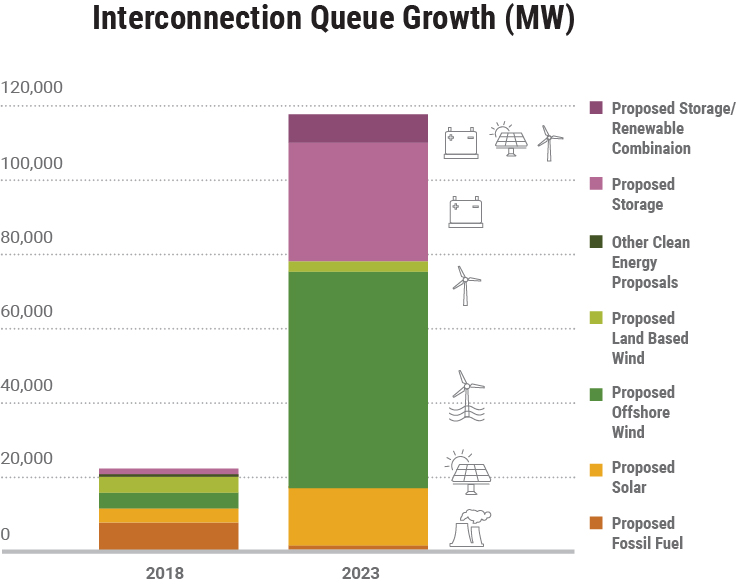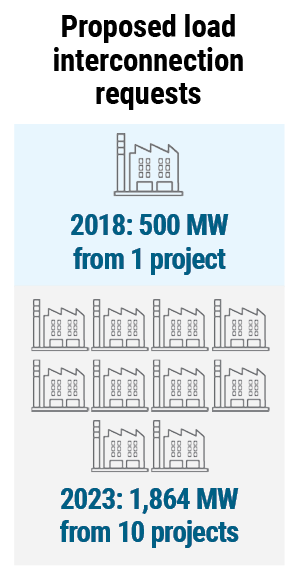Clean Energy Policies are Driving Historic Growth and Change in NYISO’s Interconnection Queue

State and federal policies promoting renewable energy and decarbonization of the grid are driving historic investments in the electric system. Here in New York, a record number of new wind, solar, and battery storage facilities are seeking to connect to the electric grid.
New York State’s Climate Leadership and Community Protection Act requires 70% of the electricity consumed in New York to come from renewable resources by 2030, and a decarbonized grid by 2040. Meeting those mandates will require substantial investments in new, carbon-free resources and additional transmission infrastructure to deliver the clean energy to customers across the state. This amount of change and investment constitutes a remaking of sorts of the electric system. It also requires careful coordination and thorough analysis to safely and reliably connect the new resources to the system, which is more challenging than it may seem.
Why? First, renewable resources like wind, solar, and battery storage facilities use “inverter-based” technology – a device that converts direct current electricity, which is what a solar panel generates, to alternating current electricity, which the electrical grid delivers. Traditional generation, like natural gas, nuclear and hydro, use “synchronous” technology, widely regarded as providing predictability in terms of output.
Integrating significant levels of inverter-based resources is a new paradigm for grid operators like the NYISO because of the unique characteristics in how they react and respond to certain events on the grid, like a power surge caused by a lightning strike, for instance. As inverter-based resources increasingly seek to interconnect to the grid, reliability concerns are evaluated through the interconnection process.
As the grid operator in New York, we are responsible for maintaining grid reliability. Part of that responsibility includes studying proposals by large generators seeking to connect and provide power to the grid. Project proposals enter our interconnection queue and undergo analyses that support the safe and reliable interconnection on the electric system and limit the risk of undue costs on consumers if system upgrades are identified.
We’ve seen an extraordinary increase in interconnection requests from new generating resources and a marked shift in the types of resources seeking to interconnect. In August 2018, the queue hosted 174 proposals. The queue at that time included 26 proposals representing more than 8,400 megawatts of fossil fuel-based generation. Now the queue contains more than 520 proposals, with more than 117,000 megawatts of proposed clean energy supply resources.


We also study large load projects, like major manufacturing facilities, that will draw substantial amounts of power from the grid. Since 2018, the number of load interconnection requests grew from just one project with a proposed 500-megawatt load to 10 load interconnection requests today, totaling 1,846 megawatts.
It is important to keep in mind that not all proposals in the interconnection queue are destined to enter commercial operations. Developers often submit multiple proposals with multiple proposed points of interconnection for what is intended ultimately to be one project. However, our planning experts must perform tariff-required analyses of each submitted proposal.
For instance, the NYISO’s interconnection queue currently includes 57 offshore wind proposals with more than 62,000 megawatts of capacity. New York’s goals call for 9,000 megawatts of offshore wind capacity to be installed by 2035. In actuality, not all offshore wind proposals in the NYISO’s queue will be built because many developers are examining multiple points of interconnection for the same project to identify which one provides the best option from an engineering and an economical perspective. Ultimately, a developer will move forward with just one proposal to be studied in our Class Year Study, but significant effort and analysis must go into each proposal, as required by our tariff.
As discussed in a previous blog on this subject managing this kind of flexibility is increasingly a challenge. Each proposal undergoes multiple levels of examination to provide developers and investors with the information they need to make decisions about whether to proceed with their projects. That’s because some locations on the grid can more readily accommodate new facilities than others, and developers want to understand how their proposals impact the grid and what investments are needed to mitigate those impacts.
A central challenge for the NYISO and its stakeholders in building the grid of the future will be to balance the need for a rigorous interconnection process that supports reliability with developers’ desire for flexibility and timely information as they evaluate investment options. As complex proposals continue to enter our queue, we remain committed to working with stakeholders and regulators to enhance the interconnection process. Eliminating redundancies and improving coordination among developers, utilities, and the NYISO team are essential to meeting the state’s ambitious energy goals.
